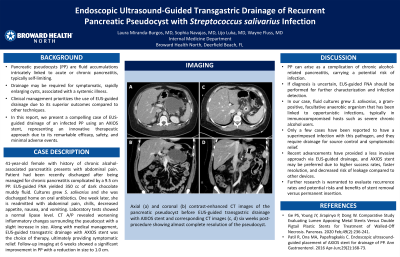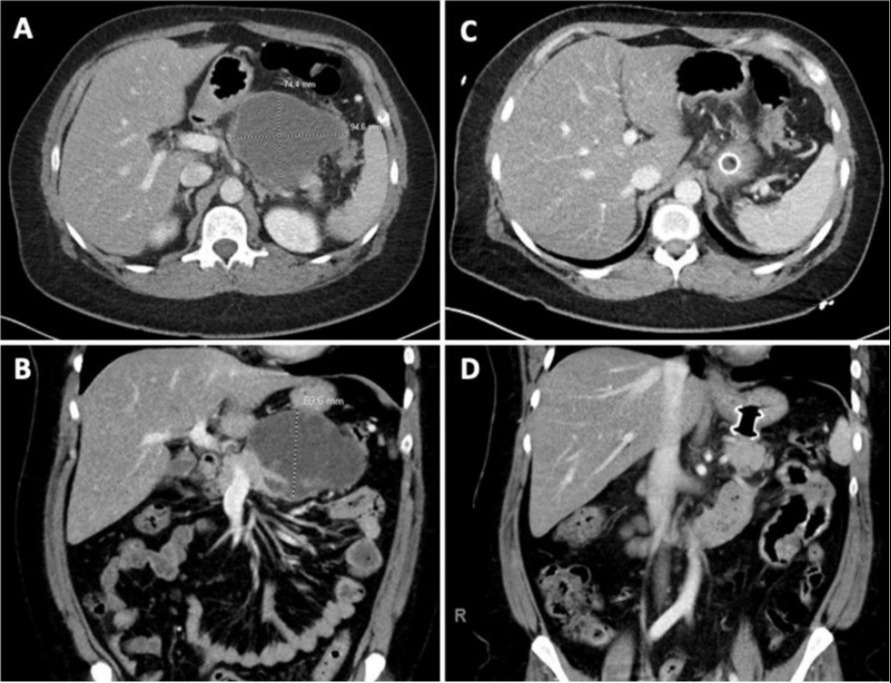Tuesday Poster Session
Category: Biliary/Pancreas
P2940 - Endoscopic Ultrasound-Guided Transgastric Drainage of Recurrent Pancreatic Pseudocyst With Streptococcus Salivarius Infection
Tuesday, October 24, 2023
10:30 AM - 4:00 PM PT
Location: Exhibit Hall

Has Audio

Laura Miranda, MD
Broward Health North
Deerfield Beach, FL
Presenting Author(s)
Laura Miranda, MD, Sophia Navajas, MD, Lijo Luka, MD, Fluss Wayne, MD
Broward Health North, Deerfield Beach, FL
Introduction: Pancreatic pseudocysts are fluid accumulations intricately linked to acute or chronic pancreatitis, typically self-limiting. Drainage may be required for symptomatic, rapidly enlarging cysts, associated with a systemic illness. Clinical management prioritizes the use of EUS-guided drainage due to its superior outcomes compared to other techniques. In this report, we present a compelling case of EUS-guided drainage of an infected pancreatic pseudocyst using an AXIOS stent, representing an innovative therapeutic approach due to its remarkable efficacy, safety, and minimal adverse events.
Case Description/Methods: 41-year-old female with history of chronic alcohol-associated pancreatitis presents with abdominal pain. Patient had been recently discharged after being managed for chronic pancreatitis complicated by a 9.5 cm pancreatic pseudocyst. EUS-guided FNA yielded 350 cc of dark chocolate muddy fluid. Cultures grew Streptococcus salivarius and she was discharged home on oral antibiotics. One week later, she is readmitted with abdominal pain, chills, decreased appetite, nausea, and vomiting. Laboratory tests showed a normal lipase level. CT A/P revealed worsening inflammatory changes surrounding the pseudocyst with a slight increase in size. Along with medical management, EUS-guided transgastric drainage with AXIOS stent was the choice of therapy, ultimately providing symptomatic relief. Follow-up imaging at 6 weeks showed a significant improvement in pancreatic pseudocyst with a reduction in size to 1.0 cm.
Discussion: Pancreatic pseudocysts can arise as a complication of chronic alcohol-related pancreatitis, carrying a potential risk of infection. If diagnosis is uncertain, EUS-guided FNA should be performed for further characterization and infection detection. In our case, fluid cultures grew Streptococcus salivarius, a gram-positive, facultative anaerobic organism that has been linked to opportunistic infections, typically in immunocompromised hosts such as severe chronic alcohol users. Only a few cases have been reported to have a superimposed infection with this pathogen, and they require drainage for source control and symptomatic relief. Recent advancements have provided a less invasive approach via EUS-guided drainage, and AXIOS stent may be preferred due to higher success rates, faster resolution, and decreased risk of leakage compared to other devices. Further research is warranted to evaluate recurrence rates and potential risks and benefits of stent removal versus permanent insertion.

Disclosures:
Laura Miranda, MD, Sophia Navajas, MD, Lijo Luka, MD, Fluss Wayne, MD. P2940 - Endoscopic Ultrasound-Guided Transgastric Drainage of Recurrent Pancreatic Pseudocyst With Streptococcus Salivarius Infection, ACG 2023 Annual Scientific Meeting Abstracts. Vancouver, BC, Canada: American College of Gastroenterology.
Broward Health North, Deerfield Beach, FL
Introduction: Pancreatic pseudocysts are fluid accumulations intricately linked to acute or chronic pancreatitis, typically self-limiting. Drainage may be required for symptomatic, rapidly enlarging cysts, associated with a systemic illness. Clinical management prioritizes the use of EUS-guided drainage due to its superior outcomes compared to other techniques. In this report, we present a compelling case of EUS-guided drainage of an infected pancreatic pseudocyst using an AXIOS stent, representing an innovative therapeutic approach due to its remarkable efficacy, safety, and minimal adverse events.
Case Description/Methods: 41-year-old female with history of chronic alcohol-associated pancreatitis presents with abdominal pain. Patient had been recently discharged after being managed for chronic pancreatitis complicated by a 9.5 cm pancreatic pseudocyst. EUS-guided FNA yielded 350 cc of dark chocolate muddy fluid. Cultures grew Streptococcus salivarius and she was discharged home on oral antibiotics. One week later, she is readmitted with abdominal pain, chills, decreased appetite, nausea, and vomiting. Laboratory tests showed a normal lipase level. CT A/P revealed worsening inflammatory changes surrounding the pseudocyst with a slight increase in size. Along with medical management, EUS-guided transgastric drainage with AXIOS stent was the choice of therapy, ultimately providing symptomatic relief. Follow-up imaging at 6 weeks showed a significant improvement in pancreatic pseudocyst with a reduction in size to 1.0 cm.
Discussion: Pancreatic pseudocysts can arise as a complication of chronic alcohol-related pancreatitis, carrying a potential risk of infection. If diagnosis is uncertain, EUS-guided FNA should be performed for further characterization and infection detection. In our case, fluid cultures grew Streptococcus salivarius, a gram-positive, facultative anaerobic organism that has been linked to opportunistic infections, typically in immunocompromised hosts such as severe chronic alcohol users. Only a few cases have been reported to have a superimposed infection with this pathogen, and they require drainage for source control and symptomatic relief. Recent advancements have provided a less invasive approach via EUS-guided drainage, and AXIOS stent may be preferred due to higher success rates, faster resolution, and decreased risk of leakage compared to other devices. Further research is warranted to evaluate recurrence rates and potential risks and benefits of stent removal versus permanent insertion.

Figure: Axial (a) and coronal (b) contrast-enhanced CT images of the pancreatic pseudocyst before EUS-guided transgastric drainage with AXIOS stent and corresponding CT images (c, d) six weeks post-procedure showing almost complete resolution of the pseudocyst.
Disclosures:
Laura Miranda indicated no relevant financial relationships.
Sophia Navajas indicated no relevant financial relationships.
Lijo Luka indicated no relevant financial relationships.
Fluss Wayne indicated no relevant financial relationships.
Laura Miranda, MD, Sophia Navajas, MD, Lijo Luka, MD, Fluss Wayne, MD. P2940 - Endoscopic Ultrasound-Guided Transgastric Drainage of Recurrent Pancreatic Pseudocyst With Streptococcus Salivarius Infection, ACG 2023 Annual Scientific Meeting Abstracts. Vancouver, BC, Canada: American College of Gastroenterology.
